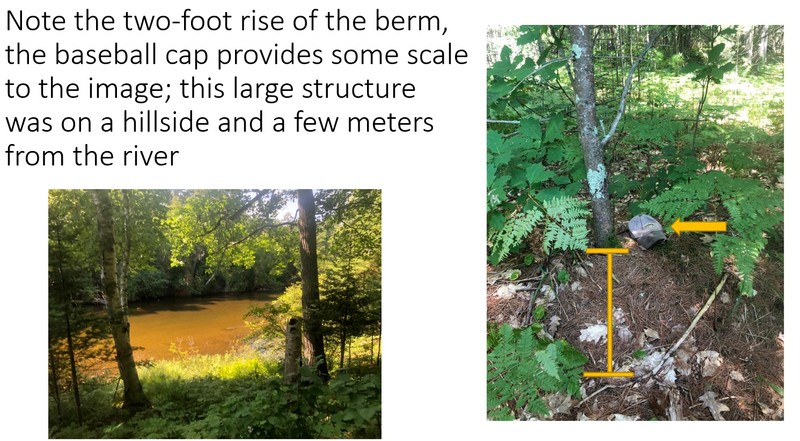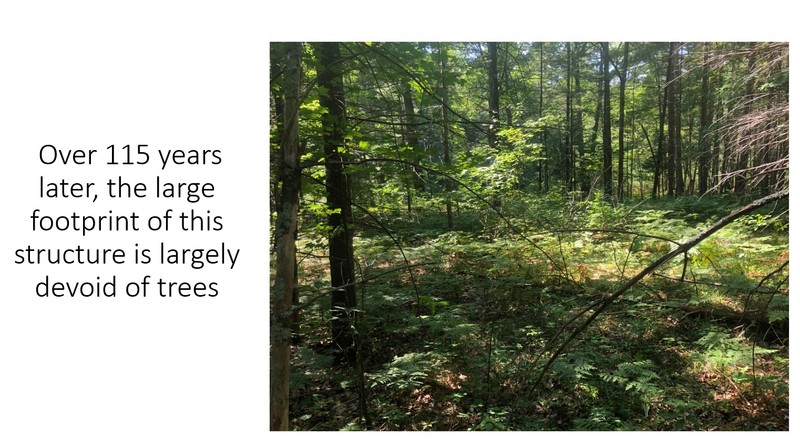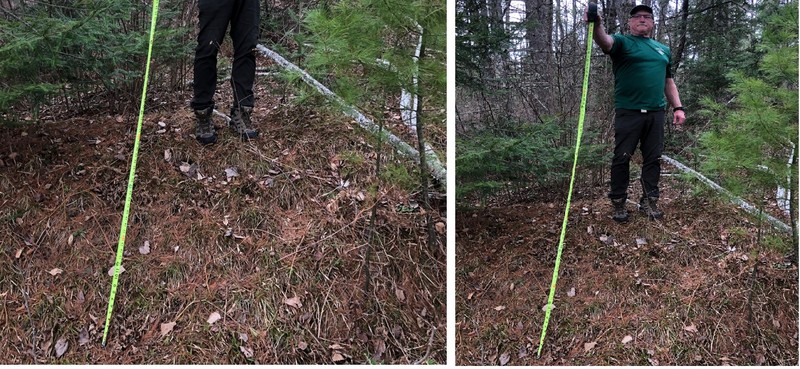Vance Lake Logging Site
Introduction
Text-to-speech Audio
The river drive logging era challenged loggers to make large camps in remote areas to harvest the white pine timber of the Northwoods. There were equipment and animals for skidding logs that needed to be hauled to pineries. And there was a need to feed hungry lumber jacks. The Vance Lake logging site is atypical and seems to be a stand-alone building site dedicated to sheltering livestock. A large bermed area, mostly devoid of trees and barbwire, marks this cultural site. Berming was a practices loggers used to seal the outside foundation of a structure with two or more feet of dirt.
Today, the Vance Lake logging site is on state forest land and can be accessed from North Lakeland Discovery Center’s Big River Trail Loop at interpretive sign 13 or the bike trail that follows the Manitowish River. It is illegal to dig, metal detect, take artifacts on public lands without a permit from the DNR Archaeologist and State Archaeologist. The Vance Lake logging site is a cultural site recorded in the Archeological Site Index and protected by state law. Observing, taking photos and sharing stories around this exciting destination are encouraged.
The Vance Lake logging site is about 135 years old and visitors being good stewards will ensure others can enjoy this unique cultural destination for generations to come.
Images
Overview of Vance Lake Logging Site and berm

Examples of animals used in logging camps

Interior area of the bermed barn, with limited tree growth

Side by side images of a three foot logging camp berm for animals at a different camp on the Manitowish River

Backstory and Context
Text-to-speech Audio
From the earliest days of logging exploration, the Vance Lake logging site stood out as a key location with great promise. In 1878, the Army Corps of Engineers selected this site as the best location for a 25-foot high Rest Lake Dam. In 1880, the dam height requirement was lowered to 15 feet, and the Rest Lake Dam was built further upstream to what is now the outlet of Rest Lake.
In 1887, the Mississippi River Logging Company immediately built a large logging camp next to the Rest Lake Dam. This logging operation initially operated in the winter months. Logs were cut, and then skidded or hauled on sleds by oxen and horses. Keeping large numbers of livestock near the logging camp created significant animal waste and watering requirements, and camp animals needed grazing lands during the warmer months.
The Vance Lake logging site was close to the Mississippi River Logging Company and provided many advantages for tending to livestock. First, the Vance Lake logging site was at the outlet of the Manitowish River where the current was swift enough to remain ice-free all winter. Evidence of barbwire growing into the middle of a large white pine by the river suggests loggers cleverly allowed animals to water themselves year-round, thus sparing laborers the need to dig wells and/or haul water.
The logging site and berms are atypical because the structure is quite large, on a significant slope, and has no root cellar or dugout area. Investigations of dozens of area logging camps reveals structures were constructed on level ground or built level into a hillside. At the Vance Lake logging site, dirt for the berms was excavated in a way that the ground in between the sloped berm was level without holes. This level and sloped ground would facilitate animal waste to move more easily into the river, where it would dissipate in the current.
The area between the berms is mostly devoid of trees, compared to the surrounding forest. After at least 115 years to recover, the soils are unable to support normal forest growth, suggesting that some trauma affected the soil, leaving it less fertile. Animal waste driven into the ground by hoofs would be a logical explanation for diminished vegetation in what was likely a large bermed animal barn.
The Mississippi River Logging Company would have required a large structure for the animals needed to support logging operations. By 1905, most river drive logging had concluded on the Manitowish River. By 1916, the property was owned by the State of Wisconsin and leased to Ethel Powell, who ran Fern Lodge for at least two decades.
Fern Lodge is also a cultural site recorded in the Wisconsin Archeological Site Index and protected by state statute form any disruption or collecting of artifacts. These sites in the same space illustrate a multi-use cultural site, which is typical throughout Wisconsin’s Northwoods.
Sources
Brenner, Paul. Interview, Koller Library. Accessed July 5th, 2024. http://mwlibrary.blogspot.com/search/label/logging..
Fries, Robert F. Empire In Pine the Story of Lumbering in Wisconsin. William Caxton Ltd: Sister Bay WI. 1989.
Interview: Craig Moore. Eagle River Historical Society Museum. Eagle River, WI 12-21-2017.
Rosholt, Malcom. Lumbermen on the Chippewa , McMillan Memorial Library Digital Collections. January 1st, 1982. Accessed July 5th, 2024. https://content.mpl.org/digital/collection/mcml/id/3757/.
Manitowish Waters Historical Society
Manitowish Waters Historical Society
Manitowish Waters Historical Society
Manitowish Waters Historical Society
